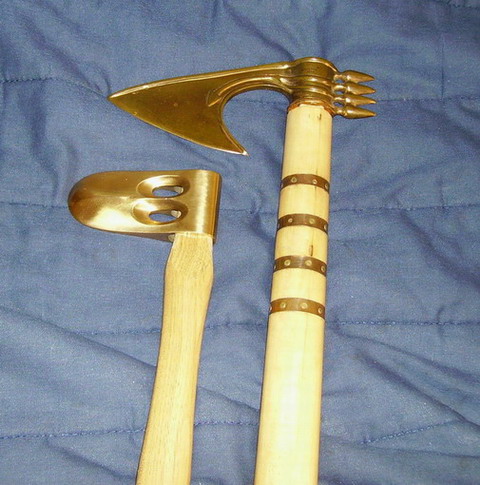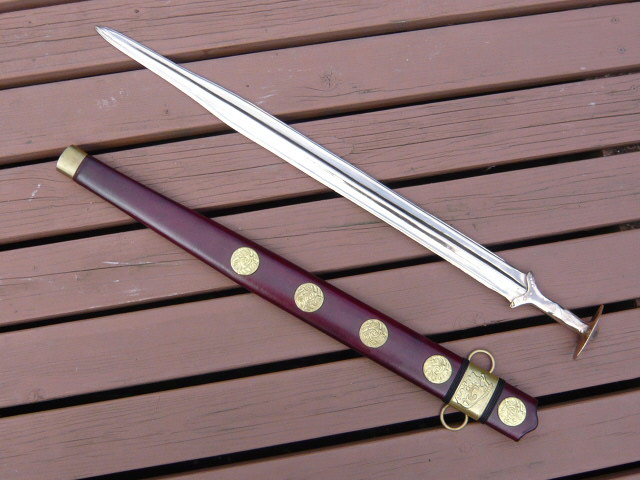Swords, left to right: Kris Cutlery, Del Tin 215a, Neil Burridge Naue II (late), Manning Imperial Canaanite khopesh, Neil Burridge Egyptian Khopesh, Neil Burridge type G, Del Tin 210a.



| David Wilson wrote: |
| The Manning Imperial "duckbill" is mounted on a pretty obviously modern hammer haft. It's a temporary arrangement until I can come up with something better. |
| Timo Nieminen wrote: | ||
Do we have art showing how duckbills were mounted? What I would take to be the obvious method is to use cord/rawhide thongs to strap it on, through the holes (and above/below the head?). This would work better if the haft sticks out into the holes. It looks like it would, if it was wider, but you have some wooden plugs/wedges to make the narrower haft fit. I was wondering if that was deliberate to make the haft less visible in the holes. |
| Gregory J. Liebau wrote: |
| An excellent array of weaponry, David. After selling my three incomplete Burridge blades some time ago, I am seriously regretting the move... It's been hard to come up with finances to purchase more to actually finish!
Are you a member over at the Bronze Age Center? I can't recall... Re-posting your collection there would be a very fine thing, indeed, as many members would appreciate being able to see these photos and even more details regarding your hilt constructions, etc. Cheers! -Gregory |
| Timo Nieminen wrote: |
| Do we have art showing how duckbills were mounted?
What I would take to be the obvious method is to use cord/rawhide thongs to strap it on, through the holes (and above/below the head?). This would work better if the haft sticks out into the holes. It looks like it would, if it was wider, but you have some wooden plugs/wedges to make the narrower haft fit. I was wondering if that was deliberate to make the haft less visible in the holes. |
| Matthew Amt wrote: |
|
There are plenty of depictions of duckbill axes in use. No thongs are used, more likely just a wedge at the top like a modern axe. The shaft is fully exposed in the holes, in fact on a few surviving examples the wood is gone but there is a decorated gold sleeve still in place. The haft is typically angled or curved forward a little, and can flair at the butt. I *love* duckbills and am jealous of yours! WINDLASS made that axe??? I'm shocked! I'm guessing it's a bit of a boat anchor, but still, it casts the right shadow, as far as I can tell. (Though I confess that's not a style I've studied!) Nice collection, thanks for sharing the photos! Matthew |

| Matthew Amt wrote: | ||
There are plenty of depictions of duckbill axes in use. No thongs are used, more likely just a wedge at the top like a modern axe. The shaft is fully exposed in the holes, in fact on a few surviving examples the wood is gone but there is a decorated gold sleeve still in place. The haft is typically angled or curved forward a little, and can flair at the butt. I *love* duckbills and am jealous of yours! WINDLASS made that axe??? I'm shocked! I'm guessing it's a bit of a boat anchor, but still, it casts the right shadow, as far as I can tell. (Though I confess that's not a style I've studied!) Nice collection, thanks for sharing the photos! Matthew |
| Jean Thibodeau wrote: |
| I have a reference book with that type of axe identified as from Luristan in origin but I guess Assyrian is regionally close by or overlaps with the Assyrian Empire at some time period ?. |
| Dan Howard wrote: | ||
These days "Luristan" has become shorthand for "illegally looted from somewhere in the Middle East". |